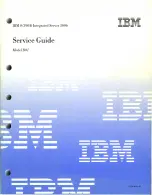
SanDisk Secure Digital (SD) Card Product Manual, Rev. 1.9 © 2003 SANDISK CORPORATION
3-1
3. SD Card Interface Description
3.1. General Description of Pins and Registers
The SD Card has nine exposed contacts on one side (see Figure 3-1). The host is connected to the SD Card using a
dedicated 9-pin connector.
3.1.1. Pin Assignments in SD Card Mode
Table 3-1 lists the pin assignments and definitions in SD Card Mode.
Table 3-1. SD Bus Mode Pad Definition
Pin #
Name
Type
1
SD
Description
1 CD/DAT3
2
I/O
3
Card Detect/Data Line [Bit 3]
2 CMD I/O
Command/Response
3 V
SS1
S
Supply voltage ground
4 V
DD
S
Supply
voltage
5 CLK I
Clock
6 V
SS2
S
Supply voltage ground
7
DAT0
I/O
Data Line [Bit 0]
8
DAT1
I/O
Data Line [Bit 1]
9
DAT2
I/O
Data Line [Bit 2]
NOTES: 1) S=power supply; I=input; O=output using push-pull drivers.
2) The extended DAT lines (DAT1-DAT3) are input on power up. They start to operate as DAT lines after the
SET_BUS_WIDTH command. It is the responsibility of the host designer to connect external pullup resistors to all
data lines even if only DAT0 is to be used. Otherwise, non-expected high current consumption may occur due to the
floating inputs of DAT1 & DAT2 (in case they are not used).
3) After power up, this line is input with /-20Kohm) pull-up (can be used for card detection or SPI mode
selection). The pull-up may be disconnected by the user, during regular data transfer, with
SET_CLR_CARD_DETECT (ACMD42) command.
















































